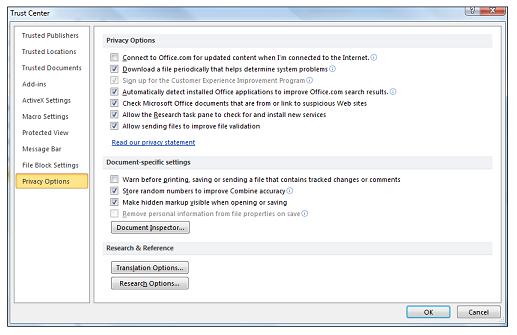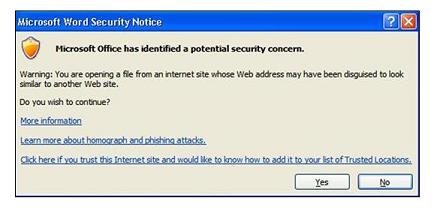Hyperlink Warning Do You Want to Continue
Excel 2013 Word 2013 Outlook 2013 PowerPoint 2013 OneNote 2013 Project Professional 2013 Project Standard 2013 Publisher 2013 Visio Professional 2013 Visio 2013 Excel 2010 Word 2010 Outlook 2010 PowerPoint 2010 Access 2010 OneNote 2010 Project 2010 Project Standard 2010 Publisher 2010 Visio 2010 Visio Standard 2010 Office 2010 Clip Organizer 2010 Clip Organizer 2013 Excel Starter 2010 InfoPath 2010 InfoPath 2013 Word Starter 2010 More...Less
This article describes the risks involved when a document that you are working on contains a link to a suspicious website or when you try to open a file from a suspicious website. Microsoft Office helps protect you from these risks with settings in the Trust Center. In Office 2013 and 2010, you can modify these settings.
Important:The option to modify these settings is not available in versions of Microsoft Office newer than 2013.
In Office, detection of suspicious links to websites is turned on by default. You can turn detection off so that you don't get security alerts. But we do not recommend this.
-
In an Office program, click the File tab.
-
Click Options.
-
Click Trust Center, and then click Trust Center Settings.
-
Click Privacy Options.
-
Under Privacy Options, select or clear Check Microsoft Office documents that are from or link to suspicious Web sites check box.
-
Click OK.
The following image is an example of the Privacy Options area of the Trust Center.

It's difficult to know if a link to a website is suspicious. However, security features in Office can prevent problems caused by clicking a link to a website that has malicious intent.
The following image is an example of an Outlook warning when a suspicious link is clicked.

Homograph attack, or spoofed websites
Options in the Trust Center can help protect you from malicious intent, such as a homograph attack, which are web addresses that use alphabet characters from different languages. The web address appears legitimate but could open a site that has malicious intent.
For example, the following web address looks legitimate, but what you cannot see is that the letter i in microsoft.com is a Cyrillic character from the Ukrainian alphabet: www.microsoft.com
How to respond to the alert message
An alert message appears when you click a link to a website that uses a potentially spoofed domain name. You can choose to visit the site, or you can click No on the alert message, which is what we recommend.
More safety and online-fraud information
You can learn more about online fraud in: Protect yourself from phishing schemes and other forms of online fraud.
Minimize the risk of cyberbullying, help children use social networking sites more safely, and use parental controls in Microsoft products to help keep your family safer online: Microsoft Online Safety.
If you know that a particular website is trustworthy, you can disable the alerts by adding the website to your Trusted Sites zone in Internet Explorer. Trusted sites can be on your organization's intranet, or sites that you learned about from trusted sources.
-
In Internet Explorer, on the Tools menu, click Internet Options.
-
On the Security tab, click Trusted sites, and then click Sites.
-
In the Add this Web site to the zone box, type or select the address of the website, and then click Add.
Note:If you want Internet Explorer to verify that the server for each website in this zone is secure before you connect to any websites in this zone, select the Require server verification (https:) for all sites in this zone check box.
-
Click OK.
Note:By default, no websites are assigned to the Trusted Sites zone, and the security level for the Trusted Sites zone is set to Low.
Source: https://support.microsoft.com/en-us/office/enable-or-disable-security-alerts-about-links-and-files-from-suspicious-websites-a1ac6ae9-5c4a-4eb3-b3f8-143336039bbe
0 Response to "Hyperlink Warning Do You Want to Continue"
Post a Comment